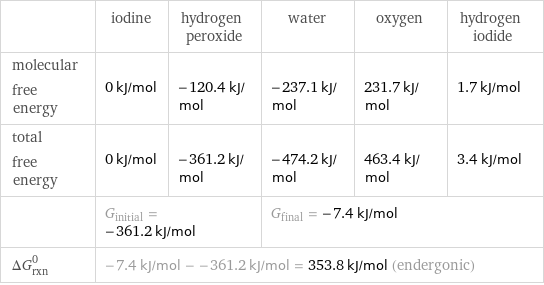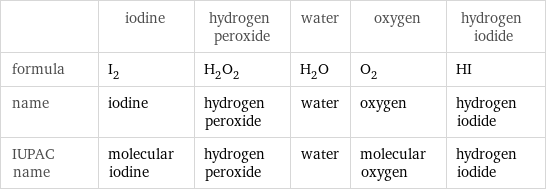Input interpretation

I_2 iodine + H_2O_2 hydrogen peroxide ⟶ H_2O water + O_2 oxygen + HI hydrogen iodide
Balanced equation

Balance the chemical equation algebraically: I_2 + H_2O_2 ⟶ H_2O + O_2 + HI Add stoichiometric coefficients, c_i, to the reactants and products: c_1 I_2 + c_2 H_2O_2 ⟶ c_3 H_2O + c_4 O_2 + c_5 HI Set the number of atoms in the reactants equal to the number of atoms in the products for I, H and O: I: | 2 c_1 = c_5 H: | 2 c_2 = 2 c_3 + c_5 O: | 2 c_2 = c_3 + 2 c_4 Since the coefficients are relative quantities and underdetermined, choose a coefficient to set arbitrarily. To keep the coefficients small, the arbitrary value is ordinarily one. For instance, set c_1 = 1 and solve the system of equations for the remaining coefficients: c_1 = 1 c_3 = c_2 - 1 c_4 = c_2/2 + 1/2 c_5 = 2 The resulting system of equations is still underdetermined, so an additional coefficient must be set arbitrarily. Set c_2 = 3 and solve for the remaining coefficients: c_1 = 1 c_2 = 3 c_3 = 2 c_4 = 2 c_5 = 2 Substitute the coefficients into the chemical reaction to obtain the balanced equation: Answer: | | I_2 + 3 H_2O_2 ⟶ 2 H_2O + 2 O_2 + 2 HI
Structures

+ ⟶ + +
Names

iodine + hydrogen peroxide ⟶ water + oxygen + hydrogen iodide
Reaction thermodynamics
Gibbs free energy

| iodine | hydrogen peroxide | water | oxygen | hydrogen iodide molecular free energy | 0 kJ/mol | -120.4 kJ/mol | -237.1 kJ/mol | 231.7 kJ/mol | 1.7 kJ/mol total free energy | 0 kJ/mol | -361.2 kJ/mol | -474.2 kJ/mol | 463.4 kJ/mol | 3.4 kJ/mol | G_initial = -361.2 kJ/mol | | G_final = -7.4 kJ/mol | | ΔG_rxn^0 | -7.4 kJ/mol - -361.2 kJ/mol = 353.8 kJ/mol (endergonic) | | | |
Equilibrium constant
![Construct the equilibrium constant, K, expression for: I_2 + H_2O_2 ⟶ H_2O + O_2 + HI Plan: • Balance the chemical equation. • Determine the stoichiometric numbers. • Assemble the activity expression for each chemical species. • Use the activity expressions to build the equilibrium constant expression. Write the balanced chemical equation: I_2 + 3 H_2O_2 ⟶ 2 H_2O + 2 O_2 + 2 HI Assign stoichiometric numbers, ν_i, using the stoichiometric coefficients, c_i, from the balanced chemical equation in the following manner: ν_i = -c_i for reactants and ν_i = c_i for products: chemical species | c_i | ν_i I_2 | 1 | -1 H_2O_2 | 3 | -3 H_2O | 2 | 2 O_2 | 2 | 2 HI | 2 | 2 Assemble the activity expressions accounting for the state of matter and ν_i: chemical species | c_i | ν_i | activity expression I_2 | 1 | -1 | ([I2])^(-1) H_2O_2 | 3 | -3 | ([H2O2])^(-3) H_2O | 2 | 2 | ([H2O])^2 O_2 | 2 | 2 | ([O2])^2 HI | 2 | 2 | ([HI])^2 The equilibrium constant symbol in the concentration basis is: K_c Mulitply the activity expressions to arrive at the K_c expression: Answer: | | K_c = ([I2])^(-1) ([H2O2])^(-3) ([H2O])^2 ([O2])^2 ([HI])^2 = (([H2O])^2 ([O2])^2 ([HI])^2)/([I2] ([H2O2])^3)](../image_source/643bfe7f702dcfe423495c00e6feaf8d.png)
Construct the equilibrium constant, K, expression for: I_2 + H_2O_2 ⟶ H_2O + O_2 + HI Plan: • Balance the chemical equation. • Determine the stoichiometric numbers. • Assemble the activity expression for each chemical species. • Use the activity expressions to build the equilibrium constant expression. Write the balanced chemical equation: I_2 + 3 H_2O_2 ⟶ 2 H_2O + 2 O_2 + 2 HI Assign stoichiometric numbers, ν_i, using the stoichiometric coefficients, c_i, from the balanced chemical equation in the following manner: ν_i = -c_i for reactants and ν_i = c_i for products: chemical species | c_i | ν_i I_2 | 1 | -1 H_2O_2 | 3 | -3 H_2O | 2 | 2 O_2 | 2 | 2 HI | 2 | 2 Assemble the activity expressions accounting for the state of matter and ν_i: chemical species | c_i | ν_i | activity expression I_2 | 1 | -1 | ([I2])^(-1) H_2O_2 | 3 | -3 | ([H2O2])^(-3) H_2O | 2 | 2 | ([H2O])^2 O_2 | 2 | 2 | ([O2])^2 HI | 2 | 2 | ([HI])^2 The equilibrium constant symbol in the concentration basis is: K_c Mulitply the activity expressions to arrive at the K_c expression: Answer: | | K_c = ([I2])^(-1) ([H2O2])^(-3) ([H2O])^2 ([O2])^2 ([HI])^2 = (([H2O])^2 ([O2])^2 ([HI])^2)/([I2] ([H2O2])^3)
Rate of reaction
![Construct the rate of reaction expression for: I_2 + H_2O_2 ⟶ H_2O + O_2 + HI Plan: • Balance the chemical equation. • Determine the stoichiometric numbers. • Assemble the rate term for each chemical species. • Write the rate of reaction expression. Write the balanced chemical equation: I_2 + 3 H_2O_2 ⟶ 2 H_2O + 2 O_2 + 2 HI Assign stoichiometric numbers, ν_i, using the stoichiometric coefficients, c_i, from the balanced chemical equation in the following manner: ν_i = -c_i for reactants and ν_i = c_i for products: chemical species | c_i | ν_i I_2 | 1 | -1 H_2O_2 | 3 | -3 H_2O | 2 | 2 O_2 | 2 | 2 HI | 2 | 2 The rate term for each chemical species, B_i, is 1/ν_i(Δ[B_i])/(Δt) where [B_i] is the amount concentration and t is time: chemical species | c_i | ν_i | rate term I_2 | 1 | -1 | -(Δ[I2])/(Δt) H_2O_2 | 3 | -3 | -1/3 (Δ[H2O2])/(Δt) H_2O | 2 | 2 | 1/2 (Δ[H2O])/(Δt) O_2 | 2 | 2 | 1/2 (Δ[O2])/(Δt) HI | 2 | 2 | 1/2 (Δ[HI])/(Δt) (for infinitesimal rate of change, replace Δ with d) Set the rate terms equal to each other to arrive at the rate expression: Answer: | | rate = -(Δ[I2])/(Δt) = -1/3 (Δ[H2O2])/(Δt) = 1/2 (Δ[H2O])/(Δt) = 1/2 (Δ[O2])/(Δt) = 1/2 (Δ[HI])/(Δt) (assuming constant volume and no accumulation of intermediates or side products)](../image_source/8674d0d2cf3b5a2cae497cc5cf3c34f2.png)
Construct the rate of reaction expression for: I_2 + H_2O_2 ⟶ H_2O + O_2 + HI Plan: • Balance the chemical equation. • Determine the stoichiometric numbers. • Assemble the rate term for each chemical species. • Write the rate of reaction expression. Write the balanced chemical equation: I_2 + 3 H_2O_2 ⟶ 2 H_2O + 2 O_2 + 2 HI Assign stoichiometric numbers, ν_i, using the stoichiometric coefficients, c_i, from the balanced chemical equation in the following manner: ν_i = -c_i for reactants and ν_i = c_i for products: chemical species | c_i | ν_i I_2 | 1 | -1 H_2O_2 | 3 | -3 H_2O | 2 | 2 O_2 | 2 | 2 HI | 2 | 2 The rate term for each chemical species, B_i, is 1/ν_i(Δ[B_i])/(Δt) where [B_i] is the amount concentration and t is time: chemical species | c_i | ν_i | rate term I_2 | 1 | -1 | -(Δ[I2])/(Δt) H_2O_2 | 3 | -3 | -1/3 (Δ[H2O2])/(Δt) H_2O | 2 | 2 | 1/2 (Δ[H2O])/(Δt) O_2 | 2 | 2 | 1/2 (Δ[O2])/(Δt) HI | 2 | 2 | 1/2 (Δ[HI])/(Δt) (for infinitesimal rate of change, replace Δ with d) Set the rate terms equal to each other to arrive at the rate expression: Answer: | | rate = -(Δ[I2])/(Δt) = -1/3 (Δ[H2O2])/(Δt) = 1/2 (Δ[H2O])/(Δt) = 1/2 (Δ[O2])/(Δt) = 1/2 (Δ[HI])/(Δt) (assuming constant volume and no accumulation of intermediates or side products)
Chemical names and formulas

| iodine | hydrogen peroxide | water | oxygen | hydrogen iodide formula | I_2 | H_2O_2 | H_2O | O_2 | HI name | iodine | hydrogen peroxide | water | oxygen | hydrogen iodide IUPAC name | molecular iodine | hydrogen peroxide | water | molecular oxygen | hydrogen iodide
Substance properties

| iodine | hydrogen peroxide | water | oxygen | hydrogen iodide molar mass | 253.80894 g/mol | 34.014 g/mol | 18.015 g/mol | 31.998 g/mol | 127.912 g/mol phase | solid (at STP) | liquid (at STP) | liquid (at STP) | gas (at STP) | gas (at STP) melting point | 113 °C | -0.43 °C | 0 °C | -218 °C | -50.76 °C boiling point | 184 °C | 150.2 °C | 99.9839 °C | -183 °C | -35.55 °C density | 4.94 g/cm^3 | 1.44 g/cm^3 | 1 g/cm^3 | 0.001429 g/cm^3 (at 0 °C) | 0.005228 g/cm^3 (at 25 °C) solubility in water | | miscible | | | very soluble surface tension | | 0.0804 N/m | 0.0728 N/m | 0.01347 N/m | dynamic viscosity | 0.00227 Pa s (at 116 °C) | 0.001249 Pa s (at 20 °C) | 8.9×10^-4 Pa s (at 25 °C) | 2.055×10^-5 Pa s (at 25 °C) | 0.001321 Pa s (at -39 °C) odor | | | odorless | odorless |
Units
